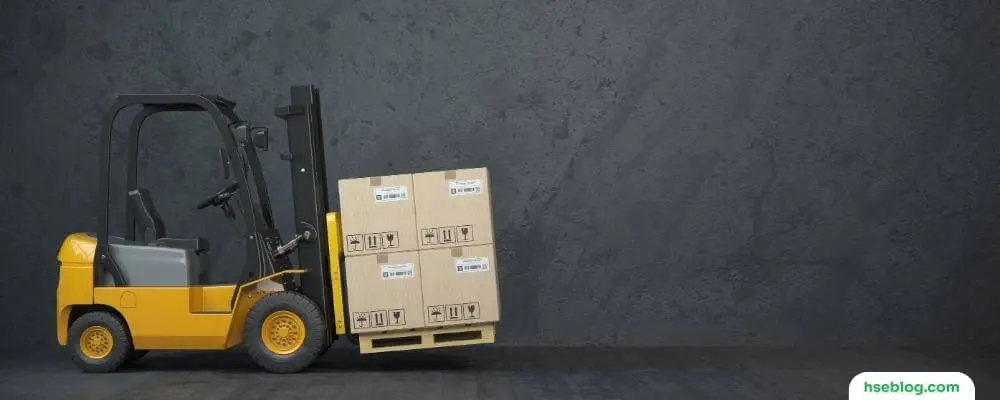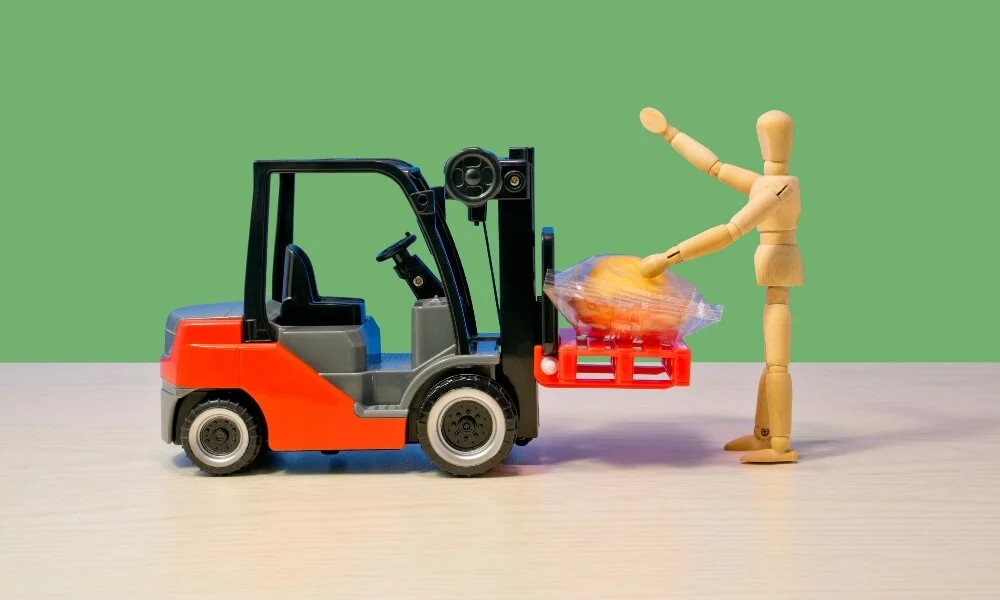Forklifts are vital in numerous industries and daily operations and supply chains. From warehouses to manufacturing plants, retail applications to various other work environments, forklifts are common. However, the familiarity and frequent use of forklifts can sometimes lead to complacency regarding safety protocols. This complacency can have severe consequences, including damage to assets, employee discipline, regulatory fines, injuries, and even fatalities.
Disturbing statistics from the Occupational Safety and Health Administration (OSHA) shed light on the gravity of forklift accidents. On average, 100 employees lose their lives yearly in forklift accidents, with an astounding 95,000 accidents occurring annually. Shockingly, many of these accidents are entirely preventable.
This blog will delve into the importance of forklift inspections and introduce a comprehensive 20-point pre-start checklist. By following this checklist diligently, operators can mitigate risks, improve safety practices, and contribute to a secure working environment. Whether you are a forklift operator, supervisor, or safety professional, this guide will equip you with the knowledge and tools to conduct thorough inspections and maintain optimal safety.
Importance Of Forklift Inspection
Proper forklift inspection ensures workplace safety, avoids equipment failures, and complies with regulatory standards. Neglecting or poorly documenting inspections can lead to severe consequences, including injuries, fatalities, financial penalties, and damage to a company’s reputation and property. Forklift inspection is of utmost importance due to the following reasons:

Safety
The primary reason for conducting regular forklift inspections is to ensure the safety of operators, employees, and bystanders. Forklifts are powerful machines that can cause serious accidents and injuries if improperly maintained. Inspections help identify any defects, malfunctions, or potential hazards that could compromise the safe operation of the forklift. By addressing these issues proactively, inspections significantly reduce the risk of accidents, protecting lives and preventing injuries.
Compliance
Inspections are essential to comply with safety regulations and standards set by governing bodies and industry guidelines. Regularly inspecting forklifts demonstrates a commitment to upholding safety protocols and legal requirements. Failure to conduct proper inspections can result in significant fines, penalties, and legal consequences, tarnishing a company’s reputation and financial stability.
Equipment Performance and Efficiency
Forklift inspections help maintain the optimal performance and efficiency of the equipment. Inspectors ensure the forklift operates smoothly and reliably by identifying and addressing any mechanical issues or defects. Well-maintained forklifts are more productive, efficient, and less likely to break down, minimizing downtime and maximizing operational output.
Cost Savings
Inspections contribute to cost savings by detecting issues early on before they escalate into more significant problems. Identifying and resolving minor repairs or maintenance needs during inspections can prevent major breakdowns and costly repairs in the future. Additionally, inspections enable predictive maintenance, allowing companies to plan and schedule maintenance activities strategically, minimizing operational disruptions and reducing overall maintenance costs.
Protection of Company Assets
Forklifts are valuable assets for companies, and their proper maintenance through inspections helps protect this investment. Regular inspections help identify wear and tear, damage, or deterioration of forklift components, allowing for timely repairs or replacements. By preserving the longevity and performance of forklifts, inspections safeguard company assets and avoid the need for premature replacements or unnecessary expenses.
Employee Engagement and Accountability
Regular forklift inspections foster a culture of safety and accountability within the organization. It emphasizes the importance of equipment maintenance and encourages operators to take an active role in ensuring the safe operation of forklifts. Companies promote engagement, responsibility, and a shared commitment to workplace safety by involving employees in inspections and providing training on proper inspection procedures.

Forklift Inspection – 20-Point Forklift Pre-Start Checklist
Forklift inspections are essential to ensure the safe operation of the vehicle. Before using a forklift, it is crucial to conduct a thorough pre-use inspection. The operator should conduct this inspection at the beginning of each work shift. If the forklift has been used by someone else during the shift, it is advisable to perform another inspection to identify any potential defects that may have arisen.
The following is a detailed 20-point checklist to guide you through a comprehensive forklift pre-start inspection:
- Horn: Check if the horn is working properly. The horn should be used at intersections and whenever visibility is obstructed to alert others of your presence.
- Hydraulic System: Inspect the mast and other parts of the forklift for any signs of hydraulic leaks. These leaks can create slipping hazards or even lead to hydraulic failure, compromising the safety of the forklift.
- Fuel Connections and Battery Terminals: Ensure the fuel connections are tight and secure. Additionally, make sure the battery terminals are covered. Loose connections or exposed terminals can cause sparks and explosions if a piece of metal falls across the terminals.
- Cleanliness: Look for any accumulation of lint, grease, oil, or other flammable materials on the forklift. These substances can pose a fire hazard, so keeping the forklift clean and free from potential ignition sources is important.
- Exhaust System: Observe if sparks or flames come from the exhaust system. Such indications may suggest a malfunction in the exhaust system, which should be addressed promptly to prevent fire hazards.
- Engine: Check for signs of engine overheating, such as unusual smells, steam, or excessive heat. An overheating engine can lead to performance issues and potentially cause breakdowns or accidents.
- Tires: Verify that the tires are at the correct pressure and free from any visible damage. Improperly inflated or damaged tires can increase the risk of tipping or losing control, especially when carrying heavy loads at high heights.
- Controls: Test all the operational controls, including lift, lower, and tilt functions. Ensure that they operate smoothly and without any issues. The controls should be clearly labelled for easy identification and operation.
- Structural Integrity: Inspect the forks, mast, overhead guard, and backrest for any signs of deformation, cracks, or damage. These structural components must be in good condition to maintain the stability and safety of the forklift.
- Lights: Check if all lights function correctly if the forklift is used during nighttime or in dark areas. Properly working lights are crucial for visibility and ensuring the forklift is easily seen by others.
- Steering: Evaluate the responsiveness of the steering. Excessive play or hard steering can impede your control over the forklift, so addressing any steering issues before the operation is important.
- Brakes: Test the brakes to ensure they stop smoothly and reliably. Sudden or unpredictable braking can cause the forklift to tip over, leading to accidents or injuries.
- Parking Brake: Check if the parking brake effectively holds the forklift on an incline. This feature is critical to prevent unintended movement and maintain stability when parked on slopes.
- Seat Belts: If the forklift has seat belts, confirm they are functional, accessible, and in good working condition. Seat belts are vital safety devices that help protect the operator during sudden stops or accidents.
- Load Capacity Plate: Verify the readability of the load capacity plate. The plate provides essential information about the forklift’s maximum load capacity, ensuring operators adhere to safe load limits.
- Fluid Levels: Check the levels of various fluids, such as oil, water, and hydraulic fluid. Maintaining proper fluid levels is essential for the optimal functioning of the forklift and helps prevent mechanical failures.
- Leaks and Visible Defects: Inspect the entire forklift for any signs of leaks, cracks, or visible defects. Addressing these issues promptly can prevent further damage and reduce the risk of accidents or breakdowns.
- Mast Chains: Visually examine the mast chains, avoiding direct contact with hands. Check for signs of stretching, broken rollers, or any abnormalities. Additionally, test the mast chain tension by lifting the load backrest to eye level—proper tension ensures safe lifting operations.
- Tires and Forks: Assess the condition of the tires, including checking for cuts, gouges, or other damage. Also, inspect the forks, ensuring that the top clip retaining pin and heel are in good condition for secure load handling.
- Additional Checks: Ensure the load backrest extension functions properly, inspect the functionality of finger guards, and verify the legibility of safety decals and nameplates. Confirm the presence and legibility of the operators’ manual and log book while keeping the manual compartment free from debris. Lastly, test all other functional safety devices, such as seat belts and horns, and verify the proper functioning of the brakes, steering controls, and other operational items.
Performing a thorough pre-start inspection using this 20-point checklist will help identify any defects or issues with the forklift, enabling you to address them promptly and ensure safe operation. Remember, prioritizing safety through regular inspections is crucial for preventing accidents and maintaining a secure working environment.
Conclusion
Regular forklift inspections using a comprehensive 20-point pre-start checklist are vital for ensuring the safety of operators, employees, and pedestrians. By diligently following this checklist, operators can identify and address potential hazards, mitigate risks, and contribute to a secure work environment. Forklift inspections protect lives and help avoid costly accidents, maintain compliance with regulations, optimize operational efficiency, and safeguard company assets. Let us prioritize forklift safety through proactive inspections and cultivate a culture of responsibility, accountability, and a commitment to the well-being of all those involved in forklift operations.

